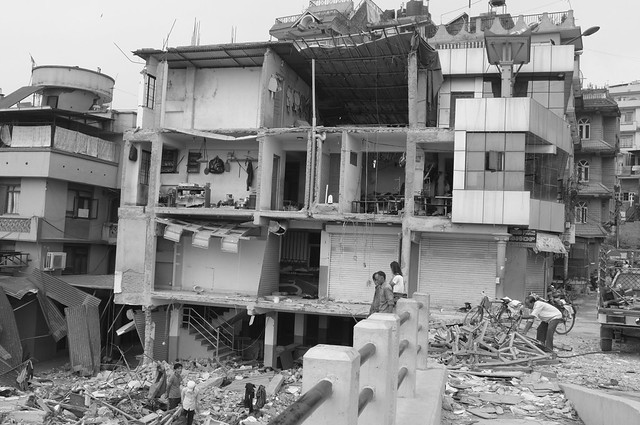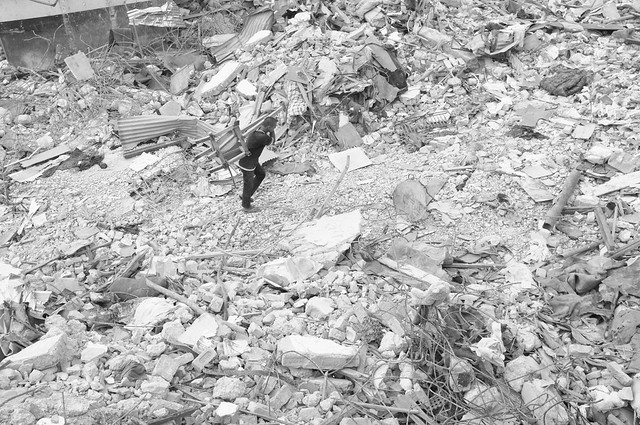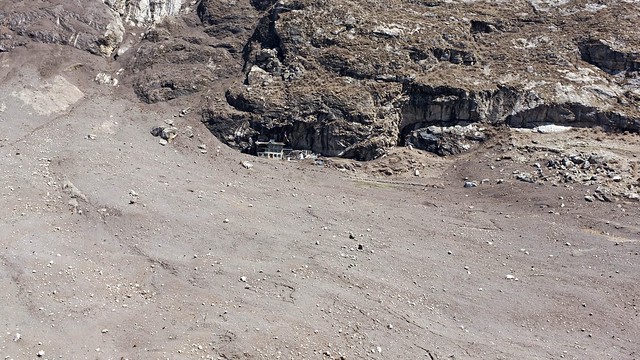April 25, 2015.
I was enjoying an idyllic vacation in Mauritius, swimming with the largest animals in the world. When we returned to the dock, my phone rang: how quickly could I get to Nepal? There had been an awful earthquake, thousands had perished, and many were still missing and/or trapped in the hills and passes of the high Himalayas.
I was in Kathmandu a few days later and stayed for nearly a month. When I returned, I blogged about the scenes in Kathmandu, but not about what I had seen in the Langtang valley. It’s still hard to grasp, really.

Photo by Yosarian, licensed under the Creative Commons Attribution-Share Alike 4.0 International, 3.0 Unported, 2.5 Generic, 2.0 Generic and 1.0 Generic license.
My daughter had hiked the valley a year prior with a school group, and I imagined a trail with a few scattered huts and hostels along the way. As it turns out, Langtang, a village situated in a wider part of the valley and a popular resting place for hikers, had at one time consisted of dozens of guest houses, hotels, and tea houses.
On April 25, a 7.8 quake shook loose a glacier high above Langtang village, causing an avalanche that instantly dumped 40 million tons of earth on the village. In an instant, a layer of rock, mud, and ice up to 30 meters deep covered an area a mile and a half long and half a mile wide. The shock wave generated by the avalanche flattened trees on the opposing slope and stripped their bark for miles in either direction. Ice and debris rained on the next village up the valley, carried by the wind generated by the impact.

I arrived three days after the quake. My job was to work with a small team of search and rescue specialists to find survivors and to bring them to safety. Others had already scoured, unsuccessfully, the tent camps throughout the city of Kathmandu looking for any foreign tourists that might have sheltered there. We had a few leads – there were pockets of hikers trapped in various locations along popular hiking trails; often one of them would have a satellite phone or a GPS messaging device, and we’d plot their locations and plan on how to get them out. But this proved to be difficult, because the Nepalese government – probably quite appropriately – had nationalized all of its helicopters in order to centralize control of a limited, but vital resource. But we continued to plead with them, to try and get a few hours of air time to fly over the valley, where tourists of various nationalities had not been heard from since before the quake.
Like many of the hotels in the city, the one I was staying in was deemed partially unsafe, and we were served our meals outside on the lawn, due to thea large crack running across the ceiling of the dining room. Other guests in my hotel were a mix of rescue NGOs, shellshocked tourists waiting for a flight out, and just-arrived search-and-rescue teams, from Virginia, Los Angeles, Spain, Israel, and other countries whose citizens had been reported missing in the region.
After a few days of calls, we were told we’d finally have a helicopter for a few hours. We knew three Americans were missing, but at this point, everyone in the search effort had started working together as a team, regardless of nationality. Pictures of any found remains were shared among a quickly-evolving network. In the office, I was asked why I was spending so much time on social media; I explained that the photos that had been sent by families missing their loved ones were school photos or other posed shots in their “Sunday best.” But Facebook and Twitter held clues to how they might have looked after weeks of hiking in the Himalayas, including clothes they might have been wearing, or people they ran into along the way who might have additional information. From what we could piece together, it appeared that all three had been having lunch in Langtang Village, one of the principal stops along the scenic Langtang trail, when the earthquake struck.
We boarded the chopper and set off from Kathmandu’s airport. The pilot carefully navigated between thick banks of fog, having to reverse course several times when he lost all visibility. We weren’t sure we’d make it out of the city, which is enclosed by mountains and often covered by clouds. But eventually, he broke through, and we were greeted by vistas of snow-covered mountains, babbling brooks and dense forests…interspersed by small villages precariously perched on small ledges and surrounded by terraced rice fields.


Eventually the pilot pointed to a wider part of the valley up ahead. It was featureless, just mud flats. To the right I saw that the trees had been flattened, as if by a nuclear blast. As we flew over the place where Langtang Village had once been, I could see to my left a single building, backed up in a shallow cave under the cliff face, that was still standing; nothing else but mud and rock. This was all that was left of Langtang village.
We continued on, passing over an area where buildings had once stood, but now was nothing but rubble. A few kilometers further, we passed over Kyanjin Gompa, whose residents later reported that the shock wave from the avalanche had pelted their village with stones and ice. Seeing no signs of life, we made a wide “U” turn and headed back toward what had been Langtang.
As we passed over for a second time what had once been a bustling village just days earlier, we saw people in the distance waving. The pilot swerved and we landed. A half dozen Nepali survivors asked for help; we gave them the MREs we had on board, and one of my colleagues applied first aid to a head wound and gave an older gentleman a handful of Tylenol. They pointed to the lower part of the valley, behind us, and said there was a body of a foreigner, so we went to investigate. We found a young woman, face down, and after retrieving identification from her pocket, took a GPS reading and carefully wrapped her body in a mylar blanket to make her easier to find. And remounted the chopper to continue our search for survivors.
It was time to return to Kathmandu – helicopters struggle at those altitudes – and on the way back we saw no other signs of life along the trail. I reported the coordinates of the young woman we had found to the German embassy, and the following days were spent coordinating flights to ferry pockets of stranded survivors to the capital, and occasionally checking the morgue for updates. The evenings were spent speaking to the families of those who were still unaccounted for. We interviewed other survivors and scoured social media for clues, and although it was becoming near-certain that the three missing Americans had been in Langtang village at the time of the avalanche, I wasn’t ready to tell their families to give up hope. Because I didn’t want to give up hope. But the sheer scale of destruction at Langtang was hard to argue with. And the aftershocks continued constantly – day and night – on an average of every 15 or 20 minutes. After awhile, most of us stopped noticing them; the Earth moving beneath our feet somehow became normal.
As the death toll continued to climb – 7,000…8,000…eventually 9,000 – stories of tragedy and heroism continued to pour in. Hundreds of climbers remained stranded at Everest Base Camp, but flights were operating and they were in no immediate danger. The media talked about how this earthquake had been a long time coming, and all previous scenarios hadpredicted the destruction of Kathmandu. Yet in the end, Kathmandu was relatively unscathed; the vast majority of deaths occurred in remote, mountainous parts of Nepal. We had seen the evidence on our flight – signs of landslides and avalanches in random places on otherwise pristine green mountain slopes.

Five years after, I still remember the pride I felt when I saw four American V-22 Ospreys land at Kathmandu’s airport. The international community was mounting a massive rescue effort – India sent scores of people and helicopters, in addition to Spain and several other European countries – and I was glad to see us join in the effort.
On May 12, a 7.3 magnitude aftershock hit Kathmandu. Far less powerful than the initial 7.8, but still scary. Fortunately, it caused relatively few deaths – compared to the initial shock. But I remember drunkenly (it felt) stumbling out of the building I was in and taking a knee on the grass outside. And then it was over. And then we all got back to looking for the folks who had gone missing, though hope was fading quickly. Meanwhile, high on the mountain trail, family members of those who had gone missing had come to Nepal to look for signs of their loved one, and the massive aftershock and resulting landslides led to the military calling off its own search for survivors, in addition to ordering others off the mountain trail.
Postscript: Langtang Village has not been rebuilt. Western media tend to focus on the foreign tourists who went missing that day, but Langtang Village consisted of hundreds of Nepali people who suffered the same fate as the unlucky tourists. Stray boulders and collapsing buildings claimed the lives of locals up and down the trail, and the flow of tourists and the income they brought, whicht had allowed the people of the Langtang Valley to earn a living suddenly stopped. Five years later, hikers and tour companies are increasingly operating along the Langtang trail. While the avalanche site itself remains barren and clearly visible on satellite photos, nearby stands a memorial to those who died on April 25, and several new hotels have sprung from the rubble that lay just to the east of Langtang. One hopes that the tourism industry will recover, but like many parts of the world, the region is currently “locked down” to prevent spread of COVID-19. Meanwhile, the danger of another catastropic quake continues to lurk below the volatile Himalayas.

In memory of Nina Stechmann, who we found, and Dawn Habash, Sydney Schumacher, and Bailey Meola, whom we did not. My heart goes out to Will and Paul Schumacher, and Yasmine Habash, who came to Nepal with Reid Harris to look for their loved ones against all advice, as well as all the other family members like Khaled Habash, Rachelle Brown, and many others who, along with me, clung to the hope that Dawn, Sydney and Bailey would somehow turn up alive and safe. It is likely that Dawn, Sydney and Bailey remain to this day where they were seated on April 25, 2015 having lunch, or just stretching their legs; but if not, as Rachelle Brown noted, “Whatever the mountain doesn’t keep, we want to bring home.” I wish them the best in their efforts.











2 Responses to When Langtang Vanished